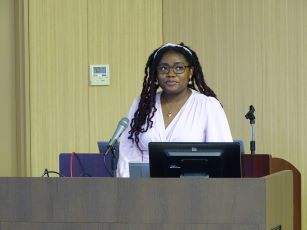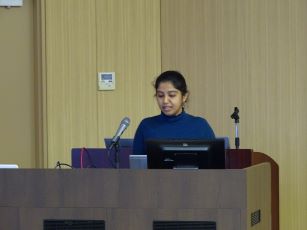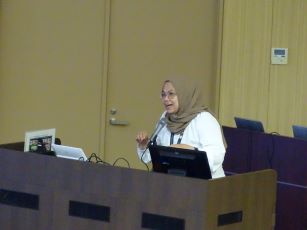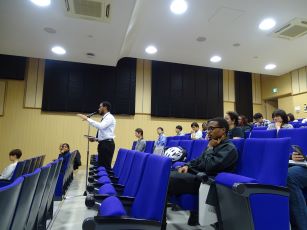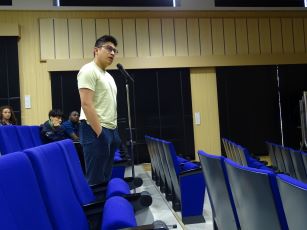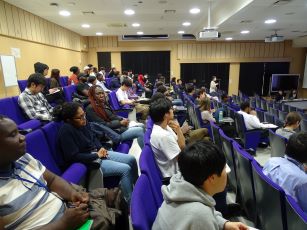- Home
- Student Activity
- Student Monthly Progress #11
The 11th Student Monthly Progress was held on April 26th, 2024.
Four students introduced their research.
【Presenter】
1. SUZUKI Tamami:Laboratory of Comparative Pathology
<Analyses for the Roles of Histone Lactylation and Tumor Metabolism in Canine Hemangiosarcoma>
2. BANDA Nelly:Laboratory of Toxicology
<Toxicological Evaluation of Lower Zambezi National Park>
3. JAYAWEERA MUHANDIRAMAGE Sasini Jayaweera:Division of Bioresources
<WQ-3810: A novel fluoroquinolone with a strong potential against fluoroquinolone-resistant Mycobacterium avium>
4. NESTI Dela Ria: Division of Collaboration and Education
<Development of Zoonotic Viral Pathogen Detection from Bats in Indonesia Using Semi-comprehensive Methods>
【Chair】
TSUKADA Anju:Laboratory of Biochemistry
SATO Jumpei:Laboratory of Infectious Diseases
❖Chairperson's Report❖
Four students introduced their research during the 11th Student Monthly Progress Meeting.
SUZUKI Tamami’s research aims to investigate the molecular pathogenesis of canine hemangiosarcoma (HSA) through lactate metabolism and histone lactylation (Kla). HSA is a malignant endothelial tumor in dogs. Tumor cells consume glucose and produce lactate, which can regulate through epigenetic transcriptional modification such as histone lactylation. Through immunohistochemistry analyses, she found high Kla levels in HSA tumor tissues, which was also confirmed by the protein expression in HSA cell lines. When glucose, a substrate for Kla, was deprived from HSA cells, surprisingly cancer cells could survive though glucose deprivation decreased Kla levels. She concluded that HSA cells modulate Kla levels in response to the nutritional condition and affect immunity. Her ongoing research focuses on detecting genes modified by Kla in glucose-dependent manner using NGS analyses.
BANDA Nelly introduced her research on setting the baseline data for monitoring metal pollution in the National Park in Zambia. Zambia is a copper mining country and mining exploration has increased. She collected acacia spp tree bark and soil samples for bioindicators in two national parks, Lower Zambezi National Park and Mosi-O-Tunya National Park. As a result, she found a significant differences in metal levels between the two national parks. The tree bark samples in Mosi-O-Tunya National Park had higher levels of metal concentration than in Lower Zambezi National Park; however, the soil samples in Lower Zambezi National Park had higher levels than in Mosi-O-Tunya National Park. She summarized that her research set the baseline data for the future toxicological monitoring for national parks in Zambia.
JAWAWEERA Sasini introduced her research about a new fluoroquinolone drug WQ-3810. Mycobacterium avium is an opportunistic pathogen for immunocompromised people. Fluoroquinolones are recommended for the macrolide-resistant M. avium infection. However, wider usage may cause the development of fluoroquinolones-resistant Mycobacterium avium. She evaluated the inhibitory effects of WQ-3810 by determining the drug concentration required to inhibit half of the enzyme activity (IC50) through DNA supercoiling inhibitory assay. She found that WQ-3810 showed dose-dependent inhibition against wild-type and mutant DNA gyrase A and showed the lowest IC50. WQ-3810 shows promise in inhibiting both wild-type and mutated forms of M.avium DNA Gyrase A, indicating potential as a therapy.
NESTI Dela Ria developed a novel cost-effective comprehensive detection method for sequencing target enrichment using Pan-viral group PCR. Bats are the major animal reservoir of zoonotic viruses. However, understanding of zoonotic virome in bats is limited. Metagenomic Next Generation Sequence (mNGS) is a promising approach for comprehensively exploring viral genome data at a significant decrease in sequencing costs. She applied pan-flavivirus primers with one-step PCR and pan-paramyxovirus primers with semi-nested PCR to amplify the viral conserved region. She have successfully optimized pan-flaviviruses and limit detection and identified novel Paramyxoviruses related to Rubulavirinae. Her method might contribute to supporting zoonotic disease investigation in bats and determining policies through a one-health approach.


